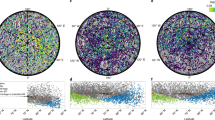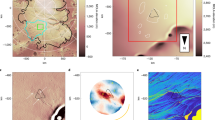Abstract
Shackleton crater at the Moon’s south pole has been suggested as a possible site of concentrated deposits of water ice, on the basis of modelling of bi-static radar polarization properties and interpretations of earlier Earth-based radar images1,2. This suggestion, and parallel assumptions about other topographic cold traps, is a significant element in planning for future lunar landings. Hydrogen enhancements have been identified in the polar regions3, but these data do not identify the host species or its local distribution. The earlier Earth-based radar data lack the resolution and coverage for detailed studies of the relationship between radar scattering properties, cold traps in permanently shadowed areas, and local terrain features such as the walls and ejecta of small craters. Here we present new 20-m resolution, 13-cm-wavelength radar images that show no evidence for concentrated deposits of water ice in Shackleton crater or elsewhere at the south pole. The polarization properties normally associated with reflections from icy surfaces in the Solar System4,5,6 were found at all the observed latitudes and are strongly correlated with the rock-strewn walls and ejecta of young craters, including the inner wall of Shackleton. There is no correlation between the polarization properties and the degree of solar illumination. If the hydrogen enhancement observed by the Lunar Prospector orbiter3 indicates the presence of water ice, then our data are consistent with the ice being present only as disseminated grains in the lunar regolith.
This is a preview of subscription content, access via your institution
Access options
Subscribe to this journal
Receive 51 print issues and online access
$199.00 per year
only $3.90 per issue
Buy this article
- Purchase on Springer Link
- Instant access to full article PDF
Prices may be subject to local taxes which are calculated during checkout


Similar content being viewed by others
References
Nozette, S. et al. The Clementine bi-static radar experiment. Science 274, 1495–1498 (1996)
Nozette, S. et al. Integration of lunar polar remote sensing data sets: Evidence for ice at the lunar south pole. J. Geophys. Res. 106, 23253–23266 (2001)
Feldman, W. C. et al. Fluxes of fast and epithermal neutrons from Lunar Prospector: Evidence for water ice at the lunar poles. Science 281, 1496–1500 (1998)
Campbell, D. B., Chandler, J. F., Ostro, S. J., Pettengill, G. H. & Shapiro, I. I. Galilean satellites—1976 radar results. Icarus 34, 254–267 (1978)
Harmon, J. K., Arvidsen, R. E., Guinness, E. A., Campbell, B. A. & Slade, M. A. Mars mapping with delay-Doppler radar. J. Geophys. Res. 104, 14065–14090 (1999)
Black, G. J. & Campbell, D. B. Rhea’s surface: Ice properties measured by radar. Bull. Am. Astron. Soc. 36, 1123 (2004)
Watson, K., Murray, B. C. & Brown, H. The behavior of volatiles on the lunar surface. J. Geophys. Res. 66, 3033–3045 (1961)
Arnold, J. R. Ice at the lunar poles. J. Geophys. Res. 84, 5659–5668 (1979)
Slade, M. A., Butler, B. J. & Muhleman, D. O. Mercury radar imaging: Evidence for polar ice. Science 258, 635–640 (1992)
Harmon, J. K. & Slade, M. A. Radar mapping of Mercury: Full disk images and polar anomalies. Science 258, 640–643 (1992)
Campbell, B. A. Radar Remote Sensing of Planetary Surfaces (Cambridge Univ. Press, Cambridge, 2002)
Hapke, B. Coherent backscatter and the radar characteristics of the outer planet satellites. Icarus 88, 407–417 (1990)
Nelson, R. M., Hapke, B. W., Smythe, W. D. & Horn, L. J. Phase curves of selected particulate materials: The contribution of coherent backscattering to the opposition surge. Icarus 131, 223–230 (1998)
Sprague, A. L., Hunten, D. M. & Lodders, K. Sulfur at Mercury, elemental at the poles and sulfides in the regolith. Icarus 118, 211–215 (1995)
Harmon, J. K., Perillat, P. J. & Slade, M. A. High-resolution radar imaging of Mercury’s north pole. Icarus 149, 1–15 (2001)
Stacy, N. J. S., Campbell, D. B. & Ford, P. G. Arecibo radar mapping of the lunar poles: A search for ice deposits. Science 276, 1527–1530 (1997)
Wilhelms, D. E., Howard, K. A. & Wilshire, H. G. USGS Map I-1162 (US Geological Survey, Washington DC, 1979)
Campbell, B. A. & Campbell, D. B. Regolith properties in the south polar region of the Moon from 70-cm radar polarimetry. Icarus 180, 1–7 (2006)
Campbell, B. A. & Hawke, B. R. Radar mapping of lunar cryptomaria east of Orientale basin. J. Geophys. Res. 110, (E9)E09002 (2005)
Zuber, M. T. & Garrick-Bethell, I. What do we need to know to land on the Moon again? Perspective article. Science 310, 983–985 (2005)
Benner, L. A. M. et al. Radar detection of near-Earth asteroids 2062 Aten, 2101 Adonis, 3103 Eger, 4544 Xanthus, and 1992 QN. Icarus 130, 296–312 (1997)
Campbell, B. A., Campbell, D. B. & DeVries, C. Surface processes in the Venus highlands: Results from analysis of Magellan and Arecibo data. J. Geophys. Res. 104, 1897–1916 (1999)
Campbell, B. A., Arvidson, R. E. & Shepard, M. K. Radar polarization properties of volcanic and playa surfaces: Applications to terrestrial remote sensing and Venus data interpretation. J. Geophys. Res. 98, 17099–17114 (1993)
Margot, J. L., Campbell, D. B., Jurgens, R. F. & Slade, M. A. Topography of the lunar poles from radar interferometry: A survey of cold trap locations. Science 284, 1658–1660 (1999)
Feldman, W. C. et al. Evidence for water ice near the lunar poles. J. Geophys. Res. 106, (E10)23231–23252 (2001)
Acknowledgements
We thank the staff of the Arecibo and Green Bank Observatories for their assistance with the observations, and J. Chandler for providing the lunar ephemeris observing files. This work was supported in part by grants from the NASA Planetary Astronomy and Planetary Geology and Geophysics Programs. The Arecibo Observatory is part of the National Astronomy and Ionosphere Center, which is operated by Cornell University under a cooperative agreement with the US National Science Foundation. The Green Bank Telescope is part of the National Radio Astronomy Observatory, a facility of the NSF operated under a cooperative agreement by Associated Universities, Inc. Author Contributions The work was initiated by D.B.C., who also wrote the initial draft of the paper. D.B.C., B.A.C., L.M.C. and J.-L.M. planned and made the observations. Software development and data reduction were done by B.A.C, L.M.C.and J.-L.M. All authors participated in the interpretation of the results.
Author information
Authors and Affiliations
Corresponding author
Ethics declarations
Competing interests
Reprints and permissions information is available at www.nature.com/reprints. The authors declare no competing financial interests.
Rights and permissions
About this article
Cite this article
Campbell, D., Campbell, B., Carter, L. et al. No evidence for thick deposits of ice at the lunar south pole. Nature 443, 835–837 (2006). https://doi.org/10.1038/nature05167
Received:
Accepted:
Issue Date:
DOI: https://doi.org/10.1038/nature05167
This article is cited by
-
Illumination and regolith temperature at China’s next candidate lunar landing site Shackleton crater
Science China Earth Sciences (2023)
-
Thick ice deposits in shallow simple craters on the Moon and Mercury
Nature Geoscience (2019)
-
Constraining the Evolutionary History of the Moon and the Inner Solar System: A Case for New Returned Lunar Samples
Space Science Reviews (2019)
Comments
By submitting a comment you agree to abide by our Terms and Community Guidelines. If you find something abusive or that does not comply with our terms or guidelines please flag it as inappropriate.



